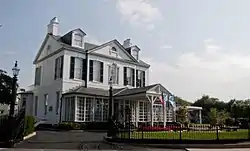| Tingey House | |
|---|---|
 Tingey House pictured in the 2010s | |
 Location of Tingey House in Washington, D.C. | |
| Alternative names | Quarters A Commandant's Quarters Commandant's House |
| General information | |
| Type | official residence |
| Architectural style | Georgian-Victorian |
| Town or city | Washington, DC |
| Country | United States |
| Coordinates | 38°52′34.1″N 76°59′40.6″W / 38.876139°N 76.994611°W |
| Named for | Thomas Tingey |
| Completed | 1804 |
| Design and construction | |
| Architect(s) | William Lovering |
Tingey House, officially known as Quarters A, is the official residence of the Chief of Naval Operations of the United States Navy. Built in 1804, it is located at the Washington Navy Yard in Washington, D.C., and is part of the Yard's historic Officers Quarters. The residence is known as Tingey House in honor of its first resident and yard commandant, Commodore Thomas Tingey. According to popular legend, Tingey's ghost haunts the property.
Location
Tingey House is located on the grounds of the Washington Navy Yard and adjoins Leutze Park, the yard's parade ground.[1] It is part of "Admirals' Row" (Officers Quarters), a group of historic homes that serve as official residences for senior Navy officers and their families.[2] The House is also called the Commandant's Quarters[3] or Commandant's House.[4]

Tingey House lies immediately east of the Latrobe Gate (also called the "Main Gate").[3]
Layout
Tingey House is a two-and-a-half-story structure with a gable roof.[3][4] According to a 1970s-era National Register of Historic Places nomination form, the first floor contains a dining room, library, kitchen, and two parlors; the second floor contains four bedrooms, and the attic contains two chambers.[3] There is a porte-cochère and enclosed porch on the south and east sides of the House.[3]
History
Early history
In 1801, Secretary of the Navy Robert Smith ordered the construction of "a house to accommodate the officer of Marines and the Superintendent of the Navy Yard."[5] The resulting building was designed by William Lovering and completed in 1804.[6] The Georgian-style[lower-alpha 1] property was named after its first resident, Thomas Tingey, the superintendent of the Washington Navy Yard.[4][7][8] As the British Army advanced on Washington during the War of 1812, the property survived Tingey's orders to burn the Washington Navy Yard. However, following the British withdrawal from Washington and before Tingey could reoccupy the home, it was looted by area residents.[9]
A memorial plaque to Tingey is fixed to the side of the house:[4]
Captain Thomas Tingey, U.S.N. who for almost half a century served his country as an officer of the Navy. He laid out the Navy Yard and for twenty-eight years was its first Commandant.

Modern era
Tingey House was used by different naval officers until 1977, when One Observatory Circle, formerly the home of the Chief of Naval Operations (CNO), was reassigned for use by the Vice President of the United States. The CNO's new official residence became Tingey House.[10][11]
In June 2008, Tingey House completed a significant renovation, which included the addition of an expanded kitchen and china closet, construction of a larger staff wing, rehabilitation of the home's greenhouse, and the remodeling of several bathrooms.[11]

The Washington Navy Yard is listed as a Superfund site, and the "Admirals' Row" group of homes suffer from nearby lead-contaminated soil, thought to be caused by lead-based paint, lead roofing, and lead water mains.[2]
Haunting
According to popular legend, the ghost of Thomas Tingey occupies Tingey House. The first reported sighting of Tingey's ghost was in 1853, by the daughter of the Navy Yard's then-commandant. In August 1960, Rear Admiral Thomas Robbins reported that his pet dog, Lucky, barked madly at an empty chair in the home's drawing room until Robbins recited the incantation, "Good evening, commodore, we're glad to be living in your house," after which the dog behaved normally.[12]
See also
- Quarters A, Brooklyn Navy Yard (former residence of the commandant of the Brooklyn Navy Yard)
Notes
- ↑ During later years, the house was "Victorianized" by expanding its windows.
References
- ↑ Vogel, Steve (16 September 2013). "Navy Yard is home to major commands". The Washington Post. Retrieved 7 June 2016.
- 1 2 Washington Navy Yard, Washington DC, Superfund Program, United States Environmental Protection Agency.
- 1 2 3 4 5 National Register of Historic Places Inventory – Nomination Form: Washington Navy Yard, National Park Service.
- 1 2 3 4 Commandant's House (PDF). Historic American Buildings Survey. 1965. p. 1.
- ↑ "Quarters A, Washington Navy Yard" (PDF). National Register of Historic Places Inventory – Nomination Form. National Park Service. April 2, 1973.
- ↑ Moeller, G. Martin (2006). AIA Guide to the Architecture of Washington Part 3. Johns Hopkins University Press. p. 67. ISBN 0801884683.
- ↑ Joshua L. Wick (January 23, 2015). "Thomas Tingey's Lasting Legacy: The Washington Navy Yard". Naval History Blog. Naval History and Heritage Command/U.S. Naval Institute.
- ↑ Gamarekian, Barbara (1 September 1985). "Where the Other Half Lives, Sir". The New York Times. Retrieved 7 June 2016.
- ↑ "You Are There: Burning of the Washington Navy Yard". Naval History Blog. U.S. Naval Institute. Retrieved 7 June 2016.
- ↑ Kennedy, Harold (August 2001). "Navy's Oldest Base Gets Clean Sweep, Fore and Aft". National Defense Magazine.
- 1 2 "Tingey House, Washington Navy Yard". Harry Braswell, Inc. Retrieved 7 June 2016.
- ↑ Krepp, Tim (2012). Capitol Hill Haunts. Arcadia Publishing. ISBN 978-1614236566.
External links
![]() Media related to Tingey House at Wikimedia Commons
Media related to Tingey House at Wikimedia Commons
